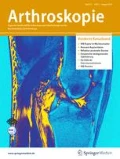Zusammenfassung
Die Versorgung von medialen und posteromedialen Kollateralbandverletzungen basiert auf der Kenntnis der anatomischen Strukturen und deren komplexem funktionellem Zusammenspiel. Das posteriore oblique Ligament (POL), der M. semimembranosus und der Innenmeniskus bilden eine funktionelle Einheit, in welcher der Innenmeniskus wie ein Bremsklotz, statisch gehalten vom POL und dynamisch vom M. semimembranosus, synergistisch mit dem vorderen und hinteren Kreuzband gegen die anteroposteriore Translation und Rotation stabilisiert. Eine Schädigung dieser Einheit zusammen mit dem vorderen Kreuzband (VKB) führt zu einer anteromedialen Rotationsinstabilität (AMRI). Die weitaus seltenere Kombination mit einer hinteren Kreuzbandverletzung erzeugt eine posteromediale Rotationsinstabilität (PMRI). Eine verbliebene posteromediale Instabilität erhöht das Risiko für ein Versagen einer vorderen oder hinteren Kreuzbandplastik erheblich. Die Versorgung der posteromedialen Instabilität sollte sich an dem akuten oder chronischen Verletzungsstadium sowie der Ausprägung der Instabilität orientieren. Therapieoptionen sind Raffnähte, die Kapselduplikatur nach Hughston, „internal bracing“ oder Sehnenaugmentationen.
Abstract
The treatment of medial and posteromedial collateral ligament injury is based on knowledge of the anatomical structures and their complex functional interplay. The posterior oblique ligament (POL), the semimembranosus muscle and the medial meniscus form a functional unit in which the medial meniscus acts like a brake pad, statically held by the POL and dynamically by the semimembranosus muscle. Also, they are stabilized synergistically by the anterior and posterior cruciate ligaments against anteroposterior (a. p.) translation and rotation. Damage of this unit in combination with injury of the anterior cruciate ligament results in anteromedial rotatory instability (AMRI). The rare combination with an injury of the posterior cruciate ligament leads to posteromedial rotatory instability (PMRI). A residual posteromedial instability increases the risk of failure of anterior or posterior cruciate ligament reconstructions. The treatment of posteromedial instability should be based on the injury stage (acute or chronic) as well as on the degree of instability. Therapy options are purse-string sutures, capsular duplication according to Hughston, internal bracing or tendon augmentation.









Literatur
Ahn JH, Lee SH (2016) Risk factors for knee instability after anterior cruciate ligament reconstruction. Knee Surg Sports Traumatol Arthrosc 24(9):2936–2942. https://doi.org/10.1007/s00167-015-3568-x
Battaglia MJ 2nd, Lenhoff MW, Ehteshami JR, Lyman S, Provencher MT, Wickiewicz TL, Warren RF (2009) Medial collateral ligament injuries and subsequent load on the anterior cruciate ligament: a biomechanical evaluation in a cadaveric model. Am J Sports Med 37(2):305–311. https://doi.org/10.1177/0363546508324969
Griffith CJ, Wijdicks CA, LaPrade RF, Armitage BM, Johansen S, Engebretsen L (2009) Force measurements on the posterior oblique ligament and superficial medial collateral ligament proximal and distal divisions to applied loads. Am J Sports Med 37(1):140–148. https://doi.org/10.1177/0363546508322890
Haimes JL, Wroble RR, Grood ES, Noyes FR (1994) Role of the medial structures in the intact and anterior cruciate ligament-deficient knee. Limits of motion in the human knee. Am J Sports Med 22(3):402–409. https://doi.org/10.1177/036354659402200317
Höher J, Offerhaus C, Akoto R (2017) Kapselduplikatur nach Hughston. Arthroskopie 30(1):32–37. https://doi.org/10.1007/s00142-016-0109-7
Jagodzinski MI, Friederich N, Müller W (2016) Das Knie: Form, Funktion und ligamentäre Wiederherstellungschirurgie. Springer, Berlin Heidelberg
Jakob RP, Staubli HU, Deland JT (1987) Grading the pivot shift. Objective tests with implications for treatment. J Bone Joint Surg Br 69(2):294–299
Noyes FR, Barber-Westin SD (2017) 19 – medial and posteromedial ligament injuries: diagnosis, operative techniques, and clinical outcomes. In: Noyes’knee disorders: surgery, rehabilitation, clinical outcomes, 2. Aufl. Elsevier, Amsterdam, S 608–635 https://doi.org/10.1016/B978-0-323-32903-3.00019-6
Wijdicks CA, Griffith CJ, LaPrade RF, Spiridonov SI, Johansen S, Armitage BM, Engebretsen L (2009) Medial knee injury: part 2, load sharing between the posterior oblique ligament and superficial medial collateral ligament. Am J Sports Med 37(9):1771–1776. https://doi.org/10.1177/0363546509335191
Author information
Authors and Affiliations
Corresponding author
Ethics declarations
Interessenkonflikt
R. Akoto, A. Preiss, J. Höher, L. Alm und K.-H. Frosch geben an, dass kein Interessenkonflikt besteht.
Dieser Beitrag beinhaltet keine von den Autoren durchgeführten Studien an Menschen oder Tieren.
Rights and permissions
About this article
Cite this article
Akoto, R., Preiss, A., Höher, J. et al. Posteromediale Rekonstruktion bei anteromedialer Instabilität. Arthroskopie 31, 229–234 (2018). https://doi.org/10.1007/s00142-018-0204-z
Published:
Issue Date:
DOI: https://doi.org/10.1007/s00142-018-0204-z

